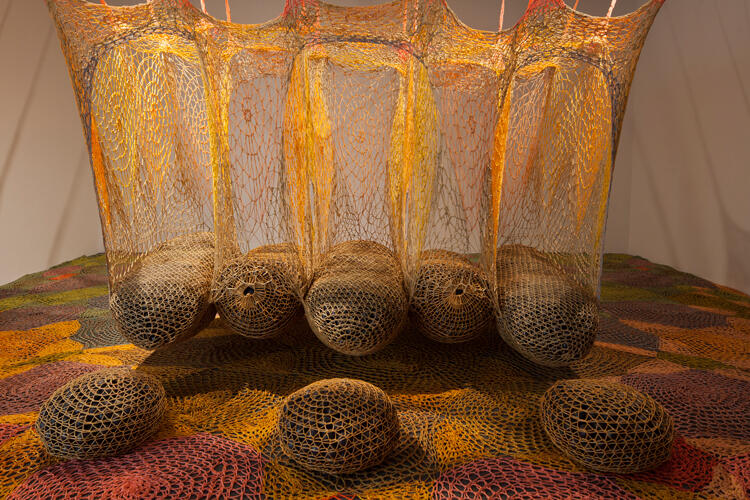ERNESTO NETO AT PINACOTECA DE SÃO PAULO
At Pinacoteca de São Paulo inaugurates Ernesto Neto: Sopro (Ernesto Neto: Blow) exhibition. Under the curatorship of the director and curator of the Brazilian museum, Jochen Volz and Valéria Piccoli, the retrospective brings together 60 works by one of the most outstanding artists of the contemporary Latin American scene. Master of space and sculptor by nature, Ernesto Neto (1964, Rio de Janeiro) intervenes with his work in the Pina Luz, located in the Jardim da Luz.

The career of Ernesto Neto, the prolific Brazilian artist who exhibits in one of the most emblematic museums and buildings of San Pablo, can be conceived in two parts. A first stage that begins in the ‘80, where Neto is introduced in the art world by dialoguing with the exhibition spaces and the changes to which those can be submitted. From this experimentation within inhabiting the exhibition spaces his artworks propose a space of coexistence, pause and awareness for the viewer. It is in this period where his famous sculptures produced with vulgar and everyday materials such as socks, spheres of white cork and spices, later transformed into gigantic installations that organically inhabit the exhibition halls appear. From these productions, Neto addresses the question of the body as an inseparable element from the mind and the spirit.
The second moment begins in 2013. Although the lines of work and the thematic axes of Neto are the same, is his theoretical sustenance the one that assumes a new position. Not as something that mutates, but as an organism that assumes a new evolved body. Since that year, the Brazilian artist has been collaborating with communities of the Amazon. Among them, the one that has most influenced in his ideas is the Huni Kuin or Kaxinawá. The relationship that Neto established with these peoples from the state of Acre, in Brazil, has reinforced the almost pantheistic vision of his works. "The word nature, as something that is outside of human beings, does not exist in this community. There is no such separation for them, "says the artist. "Living with them has given me a deep understanding of spirituality, of this force of continuity of the 'body-self' and of the 'body-environment', and also a structural 'spirit-philosophical' basis, in addition to the understanding of which there is much to discover as humanity: who are we? where we are? Where are we going?"
We can say, then, that Neto's worldview is loaded with an esotericism. In short, of a millennial knowledge that has predominated in Latin American geography before European colonization. Thus, the artist reinforces the idea of the Earth as an interdependent organism to all the elements that inhabit it.
Ernesto Neto: Sopro covers a large part of the artist's productions throughout these two moments. Also never seen and new works are exhibited. Among the most outstanding we can mention Copulônia (1989), one of the works that have positioned him as one of the most interesting artists of the Brazilian 20th century second half. "Copulônia marks the moment in which Neto begins to think that the sculpture is no longer a single volume, but a whole composed of parts," said Piccoli, curator of the exhibition.
At last, the exhibition that takes place in the Pinacoteca de São Paulo is an invitation to inhabit and perceive the world in a more harmonious way. In these times, where the pulse of the cities imposes a glass wall between human beings and nature, Ernesto Neto gives us an alternative project to walk through life.




